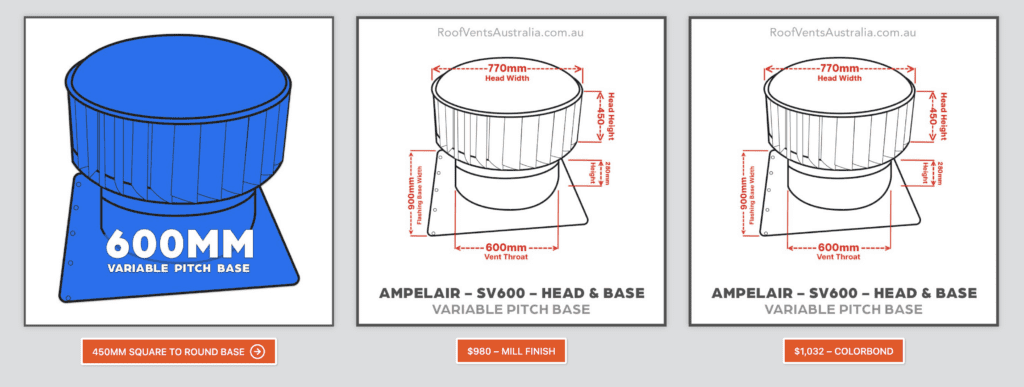Mastering Commercial and Industrial Roof Ventilation in Australia: A Comprehensive Guide
Rain Heads Custom Made Shipped Free Australia Wide – Click Here >
Dambuster Rain Heads Shipped Free Australia Wide – Click Here >
Commercial Industrial Roof Vents 300mm-950mm – Click Here >
Eco-Friendly Roofing Insulation Shipped Free – Click Here >
Gutter Sumps Shipped Free Australia Wide – Click Here >
Australia, the world’s sixth-largest country, is endowed with climatic diversity, which presents various challenges for commercial and industrial structures. From Sydney’s mild climate to Melbourne’s temperate weather and the tropical conditions of Cairns, managing moisture and temperature is a year-round concern. As such, rainwater heads and roof ventilation have gained considerable attention as indispensable elements for sustainability and energy efficiency.
This article will provide an in-depth review on best practices, installation guides, and energy-saving tactics pertinent to roof ventilation and rainwater heads. While focusing on specifics like ‘Box Gutter Rain Head Installation’ and ‘Industrial Roof Ventilation in Melbourne’, the information is applicable Australia-wide. By the end, you will have gained comprehensive insights into ‘Types of Commercial Roof Vents’, ‘Energy Savings with Roof Ventilation’, and more.
Section 1: Best Rainwater Heads for Commercial Use
Types and Materials
Rainwater heads or ‘sumps’ act as collection points for roof runoff, facilitating its flow into downpipes. Material options commonly used include galvanized steel, stainless steel, and aluminium. The Australian Standard AS/NZS 3500.3:2018 offers guidelines on the materials and installation of rainwater heads.
- Box-Type Rainwater Heads: Ideal for flat roofs and large commercial spaces. They offer greater capacity and are easier to maintain.
- Tapered Rain Heads: Often used in aesthetically-conscious projects, these are functional yet sleek.
Capacity and Sizing
The Bureau of Meteorology provides rainfall data, which is crucial for sizing rainwater heads. Capacities should align with the maximum expected rainfall, while taking into account the roof’s square footage. Often consulting an expert, such as a hydraulic consultant, is advisable for precise sizing.
Best Practices for Installation
- Box Gutter Rain Head Installation Guide: Box-type rain heads should be placed at a lower height than the gutter to ensure optimal water flow. The ‘High Front’ design can reduce the chance of overflow. Fixing brackets should be spaced no more than 1.2 meters apart for stability.
Section 2: Energy Savings with Roof Ventilation
Importance of Roof Ventilation
Roof ventilation plays an essential role in energy efficiency. According to the Australian government’s YourHome guide, effective roof ventilation can significantly reduce cooling costs in summer and control moisture in winter.
Types of Commercial Roof Vents
- Turbine Roof Vents: These are highly effective but require wind for operation. They are often reviewed positively, with ‘Turbine Roof Vents Australia Reviews’ generally highlighting their efficiency and cost-effectiveness.
- Static Roof Vents: These are passive vents with no moving parts. Despite their simplicity, they offer several benefits, such as low maintenance and durability.
- Mechanical Vents: These are electrically powered and can be controlled to provide precise ventilation, often used in larger commercial spaces.
Best Practices
- Industrial Roof Ventilation in Melbourne: Due to its fluctuating temperatures, Melbourne’s industrial spaces often require hybrid systems that combine static and mechanical vents.
Section 3: Best Laundry Ventilation Practices
In commercial settings like hospitals or laundromats, proper ventilation is key to energy savings and functionality. In accordance with AS/NZS 1668.2:2012, the Australian standard for ventilation in buildings, laundries must have adequate exhaust systems.
Points to Consider
- Humidity Control: Invest in dehumidifiers or heat recovery ventilators.
- Duct Materials: Use aluminium or galvanized steel ducting for durability and compliance with fire safety regulations.
Section 4: Reviews and Insights
Turbine Roof Vents Australia Reviews
Turbine vents are increasingly gaining popularity for their affordability and efficiency. Many Australian-based forums and review sites offer insights into various brands.
Static Roof Vent Benefits
Static vents are ideal for areas where wind-driven ventilation is not reliable. Their benefits include:
- Low Maintenance
- Energy Efficiency
- Durability
Section 5: Localised Concerns
Industrial Roof Ventilation Melbourne
Melbourne’s unique climate necessitates a specialized approach. Consider factors such as:
- Humidity: Melbourne can be quite humid, impacting both vent choice and material.
- Wind Velocity: Areas near Port Phillip Bay might benefit from turbine vents due to higher wind speeds.
Conclusion
Rainwater heads and roof ventilation systems are more than structural elements; they are enablers of energy efficiency and long-term sustainability. By adhering to Australian standards and making informed choices, significant cost and energy savings are possible. Whether you are considering a ‘Box Gutter Rain Head Installation’ or researching ‘Turbine Roof Vents Australia Reviews’, the key is to understand your unique needs and the solutions best suited to meet them.
For specific projects, consulting experts in areas like industrial roof ventilation in Melbourne or commercial roof vents in Sydney can provide targeted, localized advice.
The future is green, and the onus is on us to make our commercial and industrial spaces as sustainable and energy-efficient as possible. Happy building!
References
- Australian Standard AS/NZS 3500.3:2018: Plumbing and Drainage – Stormwater Drainage
- Bureau of Meteorology: Australian Rainfall Data
- YourHome: Government Guide on Energy-Efficient Homes
- AS/NZS 1668.2:2012: Ventilation design for indoor air contaminant control
Disclaimer: Always consult professional engineers and local authorities for compliance with national and regional codes and regulations.

